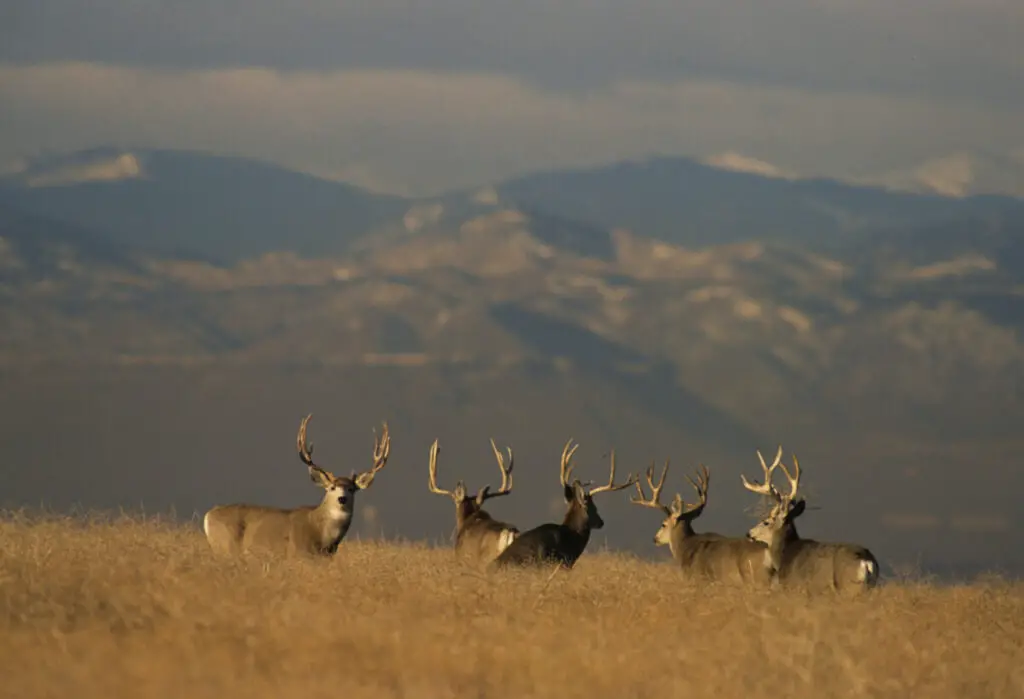Mule deer hunting in the Rocky Mountains is a trip. Muleys live in rocky steep terrain and their senses are some of the most superior in the woods. While they are a very keen animal to hunt, there are a few things, that any mule deer hunter can do to even the odds of finding these animals during hunting season.
Mule deer are most active during the early morning and evening hours before dusk. Like many big game animals, these are the times that they start to get out of their bedding areas and start foraging for food, or are returning to their feeding areas.

While the morning and evening hours are the most active times for mule deer, there are other exceptions to consider.
To be a good hunter, you have to be a student of the animal and understand their motivations. Between my first-hand experiences, observations, and relentless research on forums and videos I dug a few things up. Let’s take a deeper look at mule deer.
Time of year
Depending on what type of season you will be hunting, there will be different things to consider. The mule deer seasons are essentially broken up into three sections of fall. Early fall, Mid-fall, and Late Fall.
The early fall seasons will most likely be bowhunting seasons and will be at the tail-end of August through September. Rifle seasons will be during October and various methods of take are allowed in the November time frame depending on unit and state.
Here are some things to keep in mind for your hunting season to ensure you can find mule deer when they are most active.
Early Fall
For the late August and September timeframe in the west, the heat is one of the biggest factors that affect mule deer movement. The deer are trying to stay cool. This means you will find them moving around in the early morning and dusk hours.
For the dawn hours, the deer are feeding all throughout the night while it is cool and what you are actually doing is trying to catch them when they are finishing up this daily routine.
A big advantage that hunters have during this time of year is that the mule deer are often in bachelor groups and their antlers are in velvet.
The velvet is part of their natural process for growing new antlers every year. So what does this mean for you? The bucks will be in the open and easier to spot.
Going into thick cover causes the deer pain when the thick cover brushes up against their sensitive antlers. Because the buck’s antlers are extremely sensitive during this time of year, the mule deer like to be out in the open where they can feed without any tree limbs or brush bothering their velvet-covered antlers.
Another tip for this time of year is that the bucks are most likely in higher elevations relative to does.
They are trying to get as high as possible to escape the heat of the lower altitudes. So while you might see does at the lower elevations, it may be a better use of your time to concentrate your glassing efforts on the shady areas higher on the mountain.
When it comes to finding where the deer will be feeding, you can bet that the muleys will be looking for soft, colorful vegetation. During this time of year, if you can find any flowers, that will be a prime target for the deer. It would be even better if you can flowers in a shady place with cover, like a small grove of trees.
Mid-Fall
October is when most states have their rifle seasons. It is for a good reason also. Having a rifle allows you to take a mule deer at a longer distance but it is a fair handicap on the deer’s part since they like ghosts during this time.
Unlike September when the bucks have not been bothered by hunters yet, and are openly feeding in groups with other bucks, October is when mule deer take to thick cover. Now that the velvet has worn off, the bucks feel much more comfortable hiding in the thick sagebrush and timber.
The bucks are also much more inclined to take to thick cover such as timber, simply because of the hunting pressure. Sounds of ATV’s and gunshots around the mountains will make the deer much more wary of any unusual activity and cause them to hold tight.
One technique to counter this is to simply move slowly. If you see deer sign you know that means that there are deer there. They are probably just holding tight. You may be walking right past them.
During this time of year, do a thorough job of glassing as well.
After the morning when the deer have moved into their bedding positions, there is one more hail mary you can hope for… a re-bedding.
If the buck is bedded and starts to get too hot, he may get up to re-bed. That means he his trying to find a cooler spot from the one he picked. If you are on the binos during this time, you may see him moving in mid-day during this process.
Mid-day can be a productive time to hunt. While most hunters like to go back to camp and take a nap during the mid-day, if you are driven to make something happen, you can start slowly walking through timber and thick patches of cover.
In doing so, the hope is to get a buck to stand up near you and pause long enough for you to get a shot at him.
If there had to be a perfect combination of things to look for during this time of year it would be thick cover like timber or sage that is close to areas with good vegetation.
Take note of what any does are feeding on. Then find the same type of vegetation that is in-between large timber pockets. If there were ever a place that a buck might appear, I would place my money on this combination.
Be sure to use glassing and stalking techniques to your advantage and always pack the right gear in the fall.
Late Fall
November is the prime time to hunt mule deer. This is when the mule deer move out of the high country and start occupying foothills and valleys to begin the “rut” or mating season.
Mule deer are more active during this time than any other time during the hunting season.
Activity is not limited to morning or evening, so you will have a great chance of seeing deer in the open.
Because the bucks are full of hormones their primary concern is fighting with other bucks for mating rights to does and chasing the does themselves. The hormones overpower almost every other instinct they have, and they are much less wary of threats, so this gives hunters an extreme edge.
During this time you can spot the deer and try calling, or you can try a spot and stalk method.
During the rut, the bucks are alone no more. Wherever you can find does, just sit tight and watch them closely. If there is a buck nearby, they most certainly will find the does irresistible.
Because November is coinciding with heavy snow, a public land hunter might want to utilize an online scouting tool such as onX or Gohunt and find public land that borders some private agricultural lands.
You can sometimes watch the deer feed in farmers’ fields and then make their way into the sagebrush on public land and develop a plan to intercept them.
Weather
No matter what the season, there seem to be some patterns to be learned about the weather. Speaking from personal experience and talking with other hunters, mule deer are often active before and after any significant weather.
When I say, significant I mean something like a storm. Anything that would interrupt their needs for food or shelter.
So whether it is a heavy thunderstorm, windstorm, or snowstorm, the muleys are going to be moving around trying to find cover when a storm is coming.
After the storm, they will want to get back out and feed and make up for lost time.
So, if you are prepared to be out in the weather, it may be a good time to glass for mule deer movements during changing weather conditions.
(This article was originally published on Pintreesandsolitude.com. If it is now published on any other site, it was done without permission from the copyright owner.)
